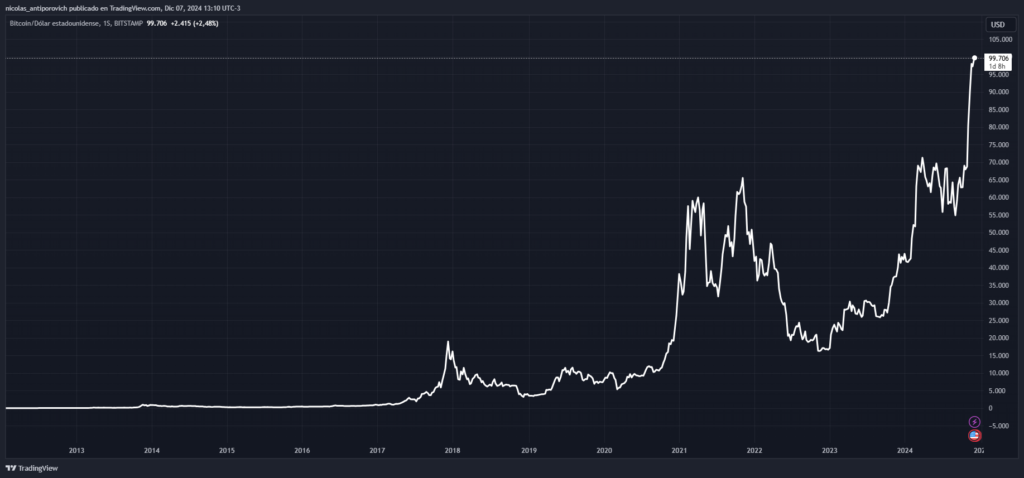-
Knowing when to sell is a skill that separates the successful from the frustrated.
-
The lack of a clear strategy can lead to impulsive decisions,
Investing in Bitcoin (BTC) and cryptocurrencies is full of challenges and decisions that can define your success or frustration.
One of the most critical and least discussed aspects among enthusiasts of BTC and altcoins is the importance of taking profits.
While it’s tempting to imagine that every rally will take us to the moon, the reality is that price curves are rarely linear, and The falls can be as fast and devastating as the rises (or much faster). In this context, realizing profits is more than an option: it is a key strategy.
To some, this idea might sound heretical. There are those who claim that “1 BTC = 1 BTC” and that the price is irrelevant because their intention is to accumulate bitcoin as a long-term asset, almost like a philosophy of life.
If you are part of this group, no problem: this reflection may not apply to you. However, if you are like most investors, who enter the market looking to make a tangible profit, then taking profits should be a central part of your strategy.
Let’s think for a moment about what it feels like to see the price of bitcoin break a major psychological barrier (for example, $100,000). There is enthusiasm, adrenaline and, above all, hope.
Many investors see these rises as confirmation that they made the right decision when entering the market. However, Experience shows that not all rises last as long as many predict. Often the market reverses, corrects and leaves many trapped in the frustration of not having sold when they had the chance.

The historical graph of the price of bitcoin highlights the high volatility of this financial asset. Source: TradingView.
This dynamic is not exclusive to bitcoin. In the case of altcoins, volatility is even more extreme. Projects that at one moment seem revolutionary and promising can experience impressive price rises only to plummet in a matter of days or weeks. Why is this happening? The answer has to do with the speculative nature of the market. When the initial enthusiasm wears off, the price can drop quickly, taking with it any unrealized profits.
Why taking profits is key
Taking profits is not an act of pessimism or a sign that you do not trust bitcoin. On the contrary, it is a risk management strategy that allows you to protect your capital and enjoy the benefits of your investments. What’s more, taking profits when you see fit could allow you to accumulate more BTC in the future.
It is about a way to transform on-screen growth into something tangible and real. For example, if the price of bitcoin is up 50% since you entered, why not cash out at least some of that profit and lock it in?
Plus, taking profits can give you a psychological advantage. Knowing that you have already secured a profit allows you to navigate market volatility more calmly. Even if the price retraces after you sold, you won’t feel like you lost. On the other hand, if the price continues to rise, you still have a portion of your position to benefit from that bullish continuation. In both scenarios, you are better prepared emotionally and financially.
When to take profits?
The golden question is: When to take profits? Although there is no single answer, a commonly used strategy is to set clear goals from the beginning. For example, you may decide to sell 25% of your position if the price reaches a certain level, another 25% if it rises even higher, and hold the rest for the long term. This approach allows you to capture profits at multiple stages while maintaining market exposure.
Another option is to use tools such as technical analysis to identify key resistance levels where the price is likely to find it difficult to continue rising. These levels are usually good points to consider taking profits, especially if the market shows signs of exhaustion. Finally, some investors prefer to take profits based on a specific percentage return on investment, such as 50% or 100%.
Taking it to the specific case of bitcoin, the head of the educational section of CriptoNoticias, Andrea Leal, has said:
How is this achieved, (knowing when to sell bitcoin)? Well, it is more of a mental state, not exact numbers or complex mathematical calculations. Perhaps for me the ideal price, to be calm, is to sell at $102,000 per bitcoin, while for others it will be to wait for it to reach $110,000 and many others will want to risk it falling to $96,000 to be able to remove themselves from the equation. ».
Lic. Andrea Leal, head of the Criptopedia section, of CriptoNoticias.
This information portal has prepared the tutorial «4 strategies to know when to sell bitcoin» which may be useful to you in this context.
What if I don’t take profits?
Not taking profits has significant risks, especially in the case of altcoins. As we mentioned before, these assets are highly volatile and can lose value quickly.
Investors who don’t sell at the right time may find themselves stuck on an emotional roller coaster, watching their gains evaporate while they wait for a rebound that may not come (or take years). Besides, Lack of a clear strategy can lead to impulsive decisionslike selling at the lowest point for fear of further declines.
A good example of this is what happened during the 2017 bull market. Many novice investors bought altcoins when their prices were at record levels, only to see them crash in 2018 during the so-called “crypto winter.” Those who didn’t take profits during the spike were left trapped, with assets that in some cases never reached their all-time highs again.
The Psychology Behind Profit Taking
Part of the challenge of taking profits is psychological. Many people are afraid to sell because they feel they will miss out on a potential future rally. This fear, known as FOMO (fear of missing out), can lead to inaction and ultimately frustration.
It is important to remember that No one can predict market movements with certainty.. Taking profits doesn’t mean you’re giving up all of the asset’s potential, but rather you’re securing a portion of that potential for yourself.
On the other hand, there is also the fear of selling too soon. Some investors are sad to see the price continue to rise after they sold. But this is where perspective comes into play: by taking profits, you’ve already achieved a goal. Celebrating your achievements, rather than lamenting what could have been, is key to maintaining a healthy mindset as an investor.
The art of playing well
In the investment game, profit taking is a skill that separates the successful from those who get caught up in the emotions of the market. This is not about abandoning your long-term vision or doubting the potential of BTC or any other asset. It’s about being strategic, protecting your capital and enjoying the real benefits of your decisions.
If you are one of those who don’t really care about the price and are in this just to accumulate, go ahead without worries. But if you are looking to maximize the value of your investments, Seriously consider integrating profit taking into your strategy.
Remember, the market will always have opportunities, but knowing when to exit a winning position can make the difference between winning and losing. At the end of the day, what counts is what you manage to materialize, not what remains floating on a screen.
Disclaimer: The views and opinions expressed in this article belong to its author and do not necessarily reflect those of CriptoNoticias. The author’s opinion is for informational purposes and under no circumstances constitutes an investment recommendation or financial advice.
Crypto Keynote USA
For the Latest Crypto News, Follow ©KeynoteUSA on Twitter Or Google News.







